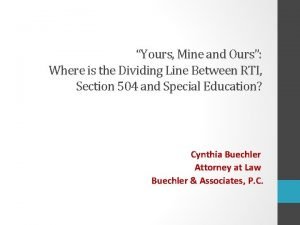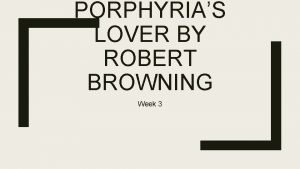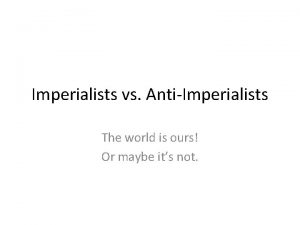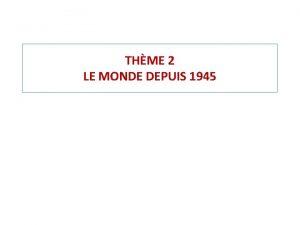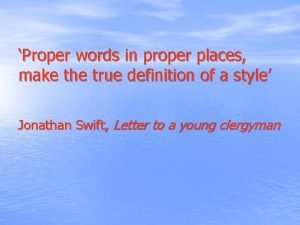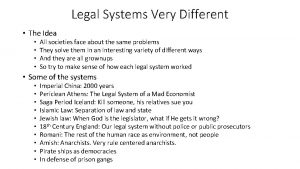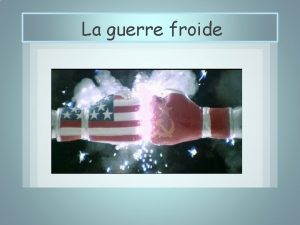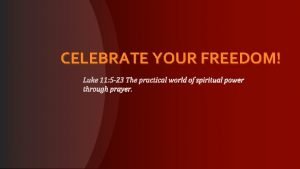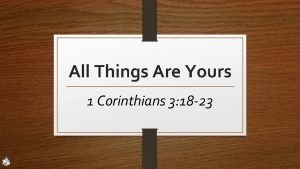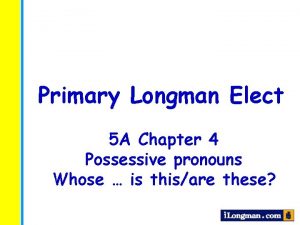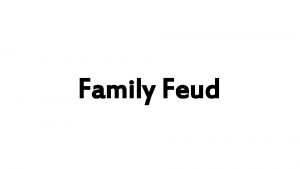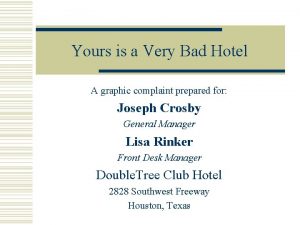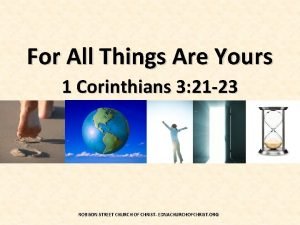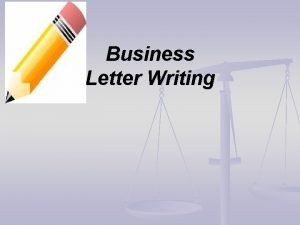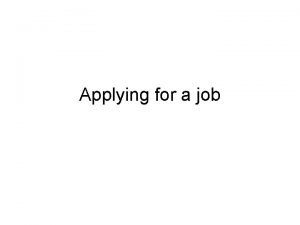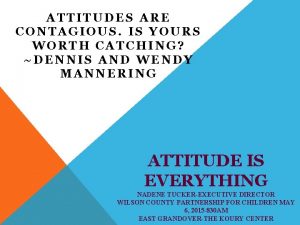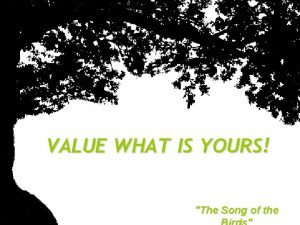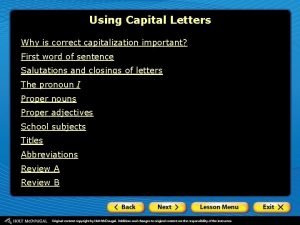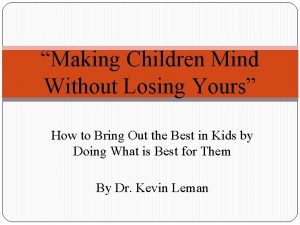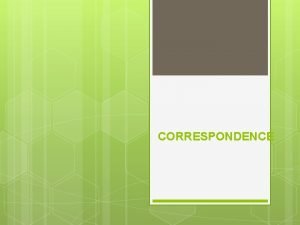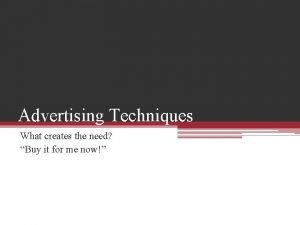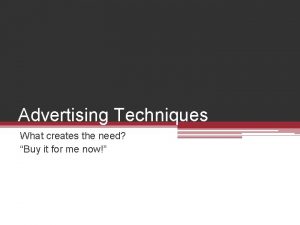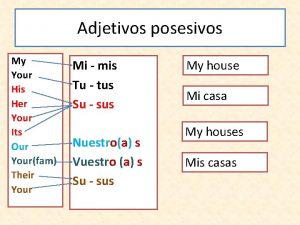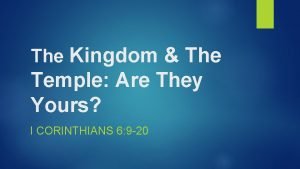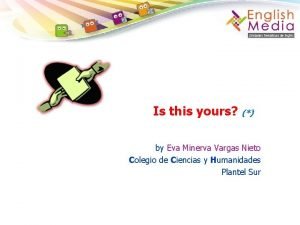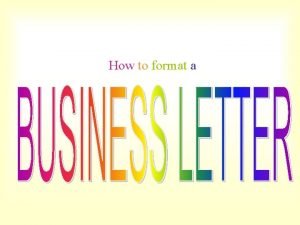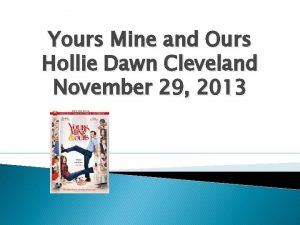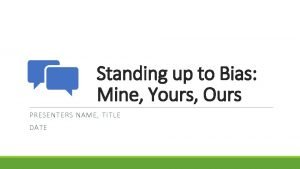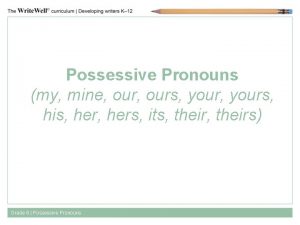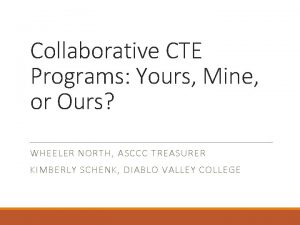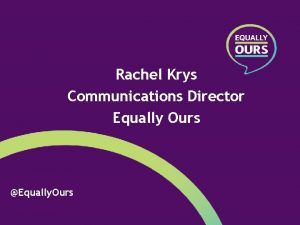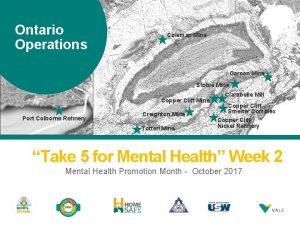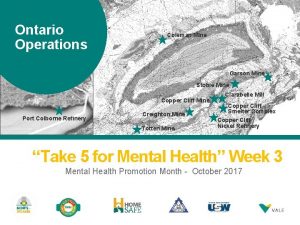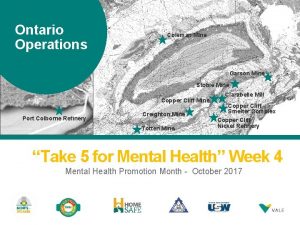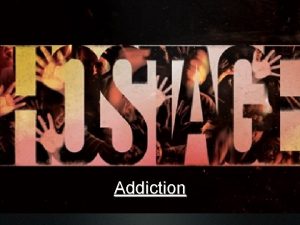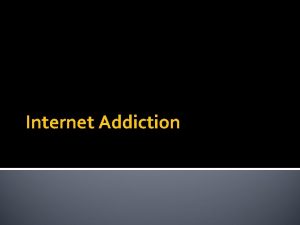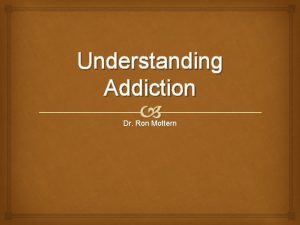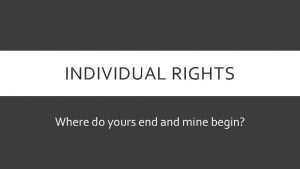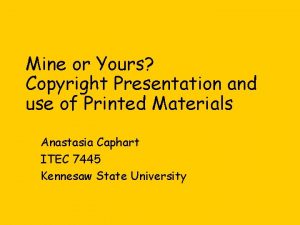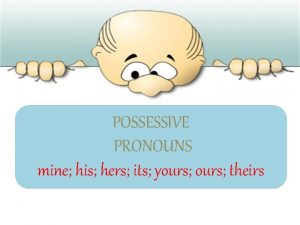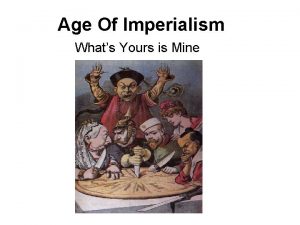Understanding Addiction Yours Mine and Ours H E




































- Slides: 36

Understanding Addiction: Yours, Mine and Ours H. E. Logue, M. D.

Bias Disclaimer n n There is no pharmaceutical support for this program. I am active in the research field and involved in clinical trials for most of the major pharmaceutical companies.

Goals and Objectives n Understand the meaning of addiction n Understand the spectrum of addiction n Understand the power of addiction n Understand treatment/recovery

Discussion Segments n n n n n Define addiction Differentiate addiction versus dependence Expand scope of addiction Explain denial Conceptualize the addictive process Give a perspective of the cost of addiction Explain the relationship between addiction and co-morbid illnesses Overview of treatment options Discuss enabling Emphasize permanence

Addiction n World Book Dictionary (1993) n “The condition of being a slave to a habit. ” n n American Psychological Association Dictionary (2007) n Addiction: “A state of psychological or physical dependence on a substance. ” n n I would add “or a substance. ” I disagree with this definition. Comprehensive Textbook of Psychiatry/VI by Harold I. Kaplan, M. D. and Benjamin J. Sadock, M. D. n Substance Abuse Syndrome: “A syndrome manifested by a behavioral pattern in which the use of a given psychoactive drug, or class of drugs, is given a much higher priority than other behaviors that once had a higher value…at the extreme is a compulsive drug-using behavior. ”

Medical Definition of Addiction Criteria of American Psychiatric Association (DSM-IV) and World Health Organization: n n Tolerance. n n Withdrawal. n n Have you spent a significant amount of time obtaining, using, concealing, planning, or recovering from your use? Desire to cut down. n n Have you ever put off or reduced social, recreational, work, or household activities because of your use? Spending significant time or emotional energy. n n Have you continued to use even though there have been negative consequences to your mood, self-esteem, health, job, or family? Putting off or neglecting activities. n n Do you sometimes use more or for a longer time than you would like? Negative consequences. n n When you stop using, have you ever experienced physical or emotional withdrawal? Difficulty controlling your use. n n Has your use of drugs or alcohol increased over time? Have you sometimes thought about cutting down or controlling your use? Have you ever made unsuccessful attempts to cut down or control your use? Answering “yes” to three or more of these questions meets the medical definition of addiction.

Who is an Addict? n An addict is a person fitting a behavioral pattern consistent with the definitions we have just read

Addiction vs. Dependence n n Addiction – being dependent on some substance or thing that so overpowers one so as to neutralize judgment controls to the point that one will behave in a manner obviously detrimental to themselves or others Dependence – a person who uses a substance or behavior to alleviate some physical or psychological need while maintaining adequate judgment to protect themselves and others

Addiction vs. Dependence Things in Common n Twin assassins n Dependency development n Tolerance development n Withdrawal without the substance n Cravings for the substance

Addiction vs. Dependence Things Not in Common n n n n Slave to the substance or behavior Powerlessness over the addictive substance Judgment warped by the desire and need for the substance Thought process commandeered Mind protects the substance, denies responsibility of drug Denies responsibility for self Blames others Makes illogical choices Willing to harm self or others to satisfy craving

Types of Addiction n n n Drugs Alcohol Smoking Gambling Food Internet Video Games n n n n Sex Pornography Work Running Racing Shopping “Shoes”

The Big Three 1. SMOKING 2. ALCOHOL 3. OPIATES

Denial n American Psychological Association Dictionary (2007) n Denial is an unconscious process that functions to resolve emotional conflict or reduce anxiety. n n Dorland’s Illustrated Medical Dictionary: 25 th Edition n n One of the mental mechanisms that we use Denial: A defense mechanism in which the existence of intolerable actions, ideas, wishes, impulses and affects are unconsciously denied. New Webster Encyclopedic Dictionary of the English Language (Library of Congress Catalog Card Number 73 -1877) n Denial: the act of denying; refusal; rejection; disownment

Conceptualize Addictive Process n n You or your children hear something fun and friendly to you: You’re twelve or fourteen and a peer offers you a free beer or cigarette or joint It seems harmless, cute, something to enjoy…

Illustration by Carla Francesca Castagno. Illustration © 2011 Outskirts Press, Inc. All Rights Reserved. Used with permission.

n n n n Fellowship and camaraderie Mind-altering effect Effect is felt – either calmed or stimulated A change from status quo Use becomes more frequent Finally, you realize that you actually want the substance; you crave it A closer look reveals… Illustration by Carla Francesca Castagno. Illustration © 2011 Outskirts Press, Inc. All Rights Reserved

Illustration by Carla Francesca Castagno. Illustration © 2011 Outskirts Press, Inc. All Rights Reserved

n n n Monster’s true nature evident You’ve been hooked You use denial You blame others You resist treatment It costs you in dollars It costs you in health It costs you in relationships It costs you in jobs You will hit bottom You die or you wake up to recovery Illustration by Carla Francesca Castagno. Illustration © 2011 Outskirts Press, Inc. All Rights Reserved

Cost of Drug and Alcohol Addiction in Alabama Courts, prisons, juvenile justice Elementary, secondary education Health system Regulation Child welfare, family assistance Public safety Prevention, treatment, research State workforce TOTAL $436 million $304 million $300 million $216 million $86 million $12 million $8 million $4 million $1. 4 billion

Cost of Addiction n n n n Cost per capita - $350 Cost for family - initial $1000 Many are too young to work Many are retired Many are disabled Some can’t find work Some are lazy Projected household cost - $2000 -$2500 annually of taxpayers

Co-morbid Illnesses n n n Borderline Personality Disorder Bipolar Disorder Schizophrenia Schizoaffective Disorder General Anxiety Disorder

Big Problem with Co-morbid Illnesses n n n The addictive behavior is disruptive and counter-productive treatment of any and all illnesses or conditions The substance alters the body’s physiology and its ability to respond appropriately to illnesses and to treatment Often, substance exacerbates underlying mental conditions, especially depression and bipolar disorder

Treatment Options n n n n n Alcoholics Anonymous, Narcotics Anonymous, Gamblers Anonymous, etc. Twelve-step programs Wilderness programs (6 -12 months) Outpatient programs In-patient dual diagnosis unit In-patient residential facilities In-patient psychiatry units Commitment Intervention

Pharmacological Treatments n Antabuse n Methadone n Chantix n Suboxone n Campral

Anagram n n n n n Admit addiction Declare freedom from addiction Declare commitment to healthy body, soul, work, and relationships Imagine a healthy lifestyle without addictive substances Commit to continual self-education about addiction Teach others all you can about addiction Involve a buddy Own up to personal responsibilities and shortcomings Never let your guard down

Expanded Anagram n Admit addiction n n Declare freedom from addiction n n This applies to any and all addictions and that’s the beauty of this anagram. As with all freedom, it must be constantly defended and won over and over again. The declaration should be your personal war on addiction, but everyone together can also make it a global effort. Declare commitment to healthy body, soul, work, and relationships n You must have a healthy body to function well day to day and to fight any battles or wars. When your soul or spirit is happy, it is easier to win personal battles. When you dedicate yourself to fostering a healthy work environment, you’re making a major effort in an extremely important segment of your life. Relationship health is a place to derive continual happiness and unequaled support. Give it everything you have.

Expanded Anagram n Imagine a healthy lifestyle without addictive substances n n Commit to continued self-education about addiction n n It should be easy to envision yourself being carefree and untethered from the addictive substance. Often people continue to look backwards and rather than feeling the joys of the future opportunities, mistakenly reach back for the temporary “fixes” of the past. The more you learn, the better prepared you will be to win your battles with addiction. The more you learn, the more you can help others. As with anything worthwhile, a lifetime of learning will not exhaust the things that are available to learn. Teach others all you can about addiction n As you repeat what you know for others, you are reinforcing the knowledge to yourself, but you are also imparting it to others who need it.

Expanded Anagram n Involve a buddy n n Own up to personal responsibilities and shortcomings n n This is important. It is someone for whom you give of yourself, but it is also someone from whom you receive in times of personal crisis or needs. Choose someone compatible. Until one is able to recognize and admit their own shortcomings, they’re not being honest with themselves. Until one accepts the responsibilities that should be their own, they’re not being equitable or fair. Never let your guard down n You must always have an ironclad defense, for there are inevitable urges and impulses that will assail you by all means possible. Avoid persons, places, and situations that are opportunistic for addictive substance and behavior.

Treatment n Work recovery daily!

Society of Enablers n n n n Pushers Family Spouse Friends Employer Doctors Therapists Ministers

Infinity Circle

Analogy to Allergy

Author’s Vignette n Smoked for 19 years (1953 -1972) n Quit three times n Dreams n 2009 - Still addicted n Recovering 37 years

War on Addiction n Within ourselves n Within our families n Within society

Who are we? n Addict (victim) n Soldier (conqueror)

Summary n n n We’re powerless to prevent a habit or the use of substances despite known dire consequences Unless we are heavily indoctrinated not to begin addictive behavior, we can easily be seduced to try it We can become hooked instantly or insidiously Various treatment options There is no cure – only day to day recovery Addiction is permanent!
 Yours mine amd ours
Yours mine amd ours Possessive adjectives
Possessive adjectives Porphyria's lover meaning
Porphyria's lover meaning Dicton chandeleur ours
Dicton chandeleur ours Glut is ours
Glut is ours Anti imperialists vs imperialists
Anti imperialists vs imperialists Caricature blocus de berlin ours analyse
Caricature blocus de berlin ours analyse The future is ours to create
The future is ours to create Ours was the marsh country
Ours was the marsh country Legal systems very different from ours
Legal systems very different from ours Allemagne puissance
Allemagne puissance For our freedom and yours
For our freedom and yours All things are yours
All things are yours What does stirrings mean in the giver
What does stirrings mean in the giver Possessive mine chapter 4
Possessive mine chapter 4 Name somthing little kids hate
Name somthing little kids hate Yours is a very bad hotel
Yours is a very bad hotel Details
Details All things are yours scripture
All things are yours scripture You said i am feeling ill
You said i am feeling ill How to write attention on a letter
How to write attention on a letter Yours sincerely or faithfully
Yours sincerely or faithfully Yours is a very bad hotel
Yours is a very bad hotel Yours is a very bad hotel
Yours is a very bad hotel Catching an attitude
Catching an attitude Value what is yours
Value what is yours Proper adjective for java
Proper adjective for java How to make your child mind without losing yours
How to make your child mind without losing yours Awaiting your reply i remain yours sincerely
Awaiting your reply i remain yours sincerely Snob appeal definition
Snob appeal definition Thousands of possibilities get yours slogan
Thousands of possibilities get yours slogan Her/his
Her/his Yours road safety
Yours road safety Are they yours
Are they yours Afternoon greetings for speech
Afternoon greetings for speech Is this yours
Is this yours Respectfully yours
Respectfully yours
